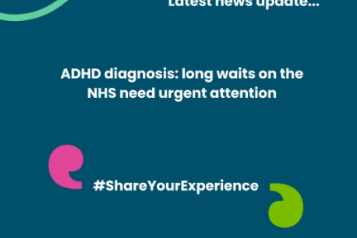Right to Choose - ADHD focus

Uploaded: October 2025
If you live in England and are an NHS patient you have the Right to Choose who delivers your care. This includes who can provide your ADHD assessment and support you with starting medication. Under the Right to Choose, you can speak with your GP and request a referral to one of the providers who is paid by the NHS to provide ADHD assessments on their behalf. These providers often have shorter waiting times than local NHS services. For more information about accessing an ADHD assessment via the Right to Choose referral pathway, please visit ADHD UK’s website: Right to Choose - ADHD UK and for more information about your choices within the NHS, please visit Your choices in the NHS - NHS.
The following is Rachel’s* experience of gaining an ADHD diagnosis following the Right to Choose pathway which we hope is helpful for others.
Misdiagnosis and unmanageable waiting times
When I was in my teens I was diagnosed with bipolar and treated for the condition for 8 years. When I moved out of my childhood home and into a different area, I was transferred over to a different Community Mental Health Recovery Service (CMHRS). I went to my first appointment and the psychiatrist said, “I don’t think you have bipolar, I think you are autistic”. It was a proper lightbulb moment. The bipolar diagnosis never felt like it ‘fit’ - and I had never responded appropriately to treatment - but suddenly it all made sense. I was the put on the waiting list for an autism assessment with my local service. This was in 2020, just before the first COVID-19 lockdown.
In October 2022 I was diagnosed with autism. During that appointment I spoke to them about the potential of also having ADHD (attention deficit hyperactivity disorder) and how a combination of autism and ADHD would make the bipolar misdiagnosis make sense. The assessor agreed and recommended I get referred for an ADHD test, which I did. I was then told that it was a 3 year wait at the point of referral.
Fast forward to September 2024, my child had just turned one and I was now juggling being a working mum and everything that comes with that. I noticed that the lack of sleep and never ending to do list resulted in my ADHD symptoms becoming much worse. I would go all day without drinking or eating, I could not focus on a conversation for more than 2 minutes without my mind wondering and I was forgetting important things, like paying bills on time.
I called the ADHD assessment team in my area and they told me they were only seeing people from September 2019, and that I was referred in October 2022 so it would be at least another 3 years’ wait. That’s when I decided that - for my own wellbeing - I couldn’t wait and would go down the Right to Choose referral pathway.
The Right to Choose referral pathway
I contacted my GP practice, who put me in contact with the referral team. They talked me through the process of being referred via the Right to Choose and gave me a list of providers and their waiting times for assessment. The provider I decided to go for was one that at the time only had a 6 week waiting list and also offered virtual appointments, which was my personal preference. My GP practice then invited me in to get some health readings for the referral, this included my blood pressure, heart rate and BMI.
2 weeks after the referral was sent I received a text from my chosen provider, notifying me that they had received my referral and asking for me to complete a few questionnaires. They sent me regular texts to remind me to complete the forms, which was helpful as I kept forgetting! Once I had completed the forms they notified me that they would be in touch when I was at the top of the assessment list.
I heard nothing for 4 months and eventually received a call to get my assessment booked in for 2 weeks’ time. I was told what I needed to have for the appointment, and this was also texted to me. A week before my appointment I received multiple texts to remind me. The last text reminder also included a bit more information about when I would receive the link for the meeting and the paperwork I needed to have.
The assessment
The assessment went really well; the assessor was very nice and understanding. At the end of the appointment I was told I had combined type ADHD, meaning I have both inattentive traits and hyperactivity. They made sure to explain the traits that I displayed that led them to this diagnosis, and how they can present. This has really helped to deepen my understanding of why I may have struggled with certain tasks and situations.
The treatment pathway
We then started to discuss ways to support me to manage my ADHD symptoms and potential medication. We spoke about my medical history and some preexisting health conditions. The assessor then recommended that I try a specific type of medication and explained exactly why they were recommending that type. However, they did not just assume that I would be happy with that decision and listened to my questions and concerns. At no point did they say explicitly “no”, but rather explained the risks so I was able to make a fully informed decision about my care.
Once we had decided on a medication to try they outlined potential side effects and ensured that I had a plan in place to tackle any issues I may face. My medication can lessen my appetite for example, combined with the fact that I forget to eat may mean I could go for a while without eating or feeling hungry. So they made sure that I knew to add in alarms and times that I would eat. A prescription code was then sent out to me, which I took to my pharmacy to collect my medication.
Since my assessment I have been titrating up to the maintenance dose of my medication. One of the challenges I have faced has been around communication with the provider’s admin team. As they provide ADHD assessments across the UK, their phone lines were always occupied and emails took a while to be answered. This did result in me coming close to not having my prescription in time. However, since that incident there have been no problems with them booking in my appointment and I have been closely monitored by this provider and have had regular check ins with the titration team to discuss how the medication is working, and any side effects I may be experiencing. I have a few more monitoring appointments left, before I am discharged by to my GP.
Overall, my experience has been a positive one. Being diagnosed with ADHD and medicated has enabled me to focus on myself and my wellbeing. I have also had an empty wash basket and been able to read a book for the first time in years! As someone who is also autistic, it has given me the headspace to work on my self esteem and identity, which is something that a lot of late diagnosed women struggle with as we mask a lot. If you think you have ADHD and feel that you would benefit from accessing medication and support, I recommend investigating the Right to Choose pathway and talking to your GP about a referral.
*Name has been changed.
Rachel's* Top Tips for accessing and attending an ADHD assessment
- Prepare to ask your GP for a referral: Have a look at the screening questionnaires and think about relevant examples of when you have shown that trait or behaviour; this could be a specific incident, or it could be more general. You may also find it useful to take along information about the Right to Choose referral pathway - NHS online and ADHD UK have information about requesting a referral via the Right to Choose pathway. For more information, please visit:
- Be aware what type of appointment you are looking for: Different providers offer a range of appointment types, so to ensure you pick the right provider for you, know if you would want an in-person appointment, virtual or over the phone. ADHD UK has information about the different providers you can access through the Right to Choose, along with information about the types of appointments that they offer. For more information, please visit: Right to Choose - ADHD UK
- Speak to someone who knows you well (bonus points if they also knew you as a child): Sometimes it helps to speak to someone who knows you well, especially if they also knew you as a child, like a parent, sibling or friend. They may be able to offer a different perspective or make you aware of traits that you may have shown without knowing.
- Look into possible medications and management techniques: To get the most out of your assessment you may want to research medications and management techniques to help you manage your ADHD in advance. This way you can discuss them with your assessor and be able to make a more fully informed decision about the medications and strategies you want to try. The ADHD Foundation has lots of information about ADHD medications and management techniques for both adults and children. For more information, visit: ADHD Foundation The Neurodiversity Charity
- Use pharmacy stock checkers to find where you can get your medication: Due to ADHD medication shortages, you may find it difficult to find a pharmacy that has the medication you need in stock. While I was starting medication, I used the ADHD & Me website, to stay up to date with medication shortages in the UK: Medication Watch - ADHD & Me and I used a pharmacy stock checker, to find out which Boots pharmacies in my area had stock of the medication I needed: Boots Pharmacy Stock Information Map. Once I was stabilised on my medication and it was added to my repeat medications, it became much easier to manage, as my pharmacy could order it for me in advance of me running out.
*Name has been changed.
